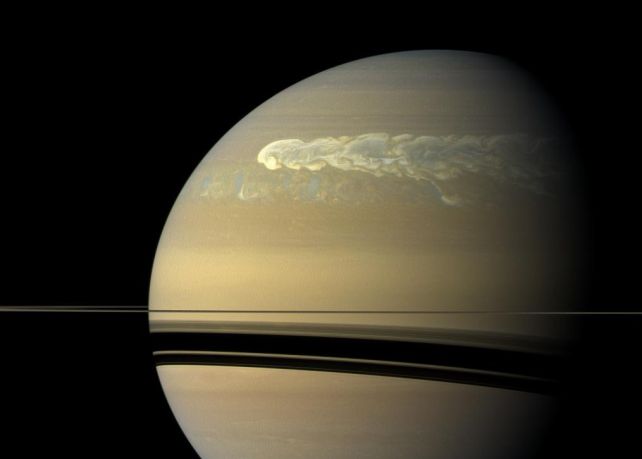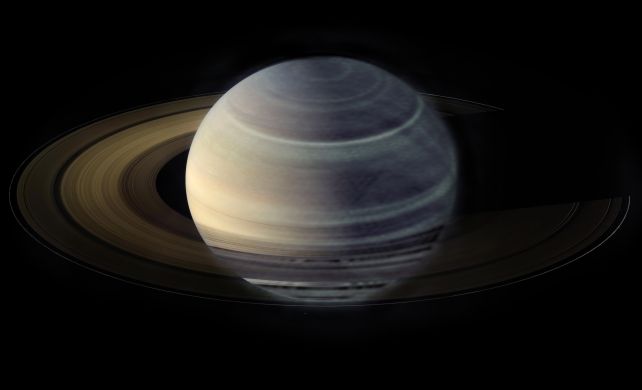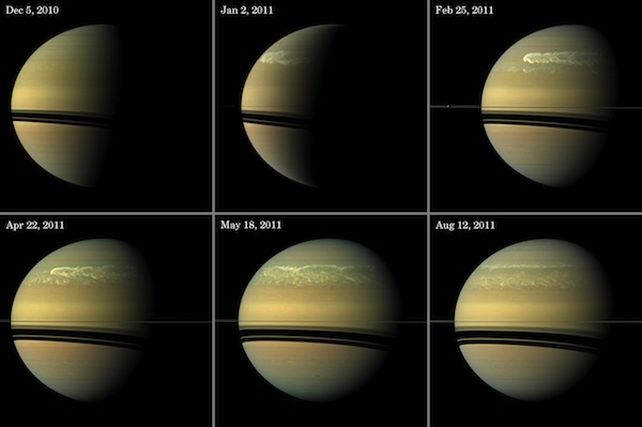Jupiter may be the stormiest place in the Solar System, but Saturn's no slouch either. A new study has found that the ringed giant also has persistent megastorms that can last a century and leave deep atmospheric scars that last much longer.
An analysis of radio waves emitted by Saturn conducted by a team of astronomers led by Cheng Li of the University of Michigan has revealed long-lasting signatures of giant storms, including equatorial storms that took place hundreds of years ago.
This is a fascinating insight into the dynamics of Saturn, and can help us figure out the cause of the strange megastorms that rage every few decades.
"Understanding the mechanisms of the largest storms in the Solar System puts the theory of hurricanes into a broader cosmic context, challenging our current knowledge and pushing the boundaries of terrestrial meteorology," says Li.

Its incredible ring system aside, Saturn looks pretty bland and beige when seen in purely optical wavelengths.
In radio light, however, a series of vividly contrasting atmospheric bands can be seen encircling the entire planet. Since ammonia blocks radio light, this striking perspective gives astronomers a way to map the ammonia in Saturn's atmosphere.
Using the National Radio Astronomy Observatory's Very Large Array, Li and his colleagues took detailed radio observations of Saturn and used them to study the distribution of ammonia in the atmosphere.
Saturn's atmosphere is primarily made up of hydrogen and helium, with just traces of water, methane, and ammonia; but that ammonia dominates the upper layer of cloud. Radio observations allow scientists to probe below that upper layer to see what lies beneath.
This is where the researchers found something curious.

"At radio wavelengths, we probe below the visible cloud layers on giant planets. Since chemical reactions and dynamics will alter the composition of a planet's atmosphere, observations below these cloud layers are required to constrain the planet's true atmospheric composition, a key parameter for planet formation models," says astronomer Imke de Pater of the University of California Berkeley.
"Radio observations help characterize dynamical, physical and chemical processes including heat transport, cloud formation and convection in the atmospheres of giant planets on both global and local scales."
The brighter bands seen in their radio images indicate a much lower concentration of ammonia in those bands. As expected, the team found ammonia in Saturn's top cloud layer; but they also found anomalous ammonia concentrations, 100 to 200 kilometers (62 to 124 miles) deep in the atmosphere. The mid-altitude region between the two is relatively ammonia free.

The team's analysis suggests the megastorms that emerge every 28 to 30 years on Saturn (so, once a Saturn year) precipitate ammonia deeper into the atmosphere, where it evaporates to be transported back to the cloud tops. Deep concentrations of ammonia, therefore, are records of ancient megastorms that can persist for hundreds of years, long after the storm itself has dissipated.
The researchers were able to trace anomalies they identified with all six of the megastorms recorded on Saturn since 1876. They also found an anomaly they believe heralds back to an even older megastorm.
Because they're both gas giants, we tend to relate events on Saturn to those on Jupiter. The team's findings also show that the two are more different than we thought. On Jupiter, temperature anomalies are associated with its alternating bands of dark and light clouds. On Saturn, it's all about the storms. This is a clue that can help us piece together the different ways gas giant exoplanets can evolve.
Meanwhile, the next megastorm is forecast to take place in 10 or 20 years. It will be fascinating to see what new things it can teach us.
The research has been published in Science Advances.
